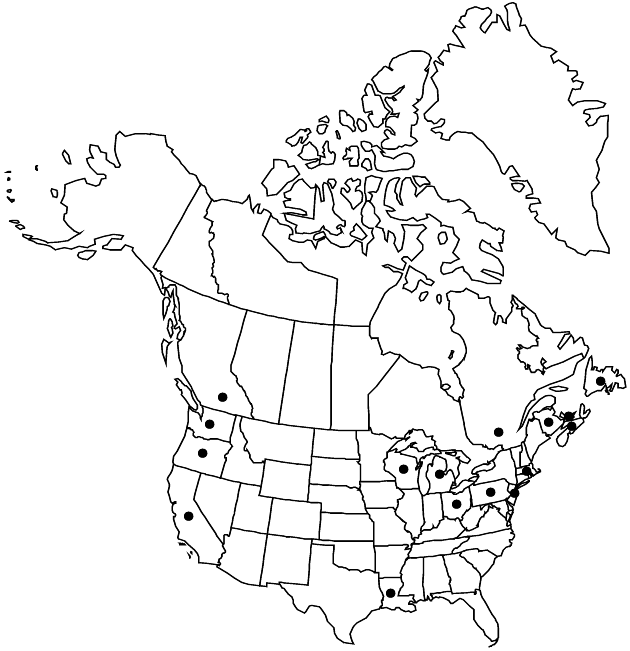Difference between revisions of "Senecio sylvaticus"
Sp. Pl. 2: 868. 1753.
FNA>Volume Importer |
imported>Volume Importer |
||
| (6 intermediate revisions by 2 users not shown) | |||
| Line 6: | Line 6: | ||
|place=2: 868. 1753 | |place=2: 868. 1753 | ||
|year=1753 | |year=1753 | ||
| + | }} | ||
| + | |special_status={{Treatment/ID/Special_status | ||
| + | |code=I | ||
| + | |label=Introduced | ||
}} | }} | ||
|basionyms= | |basionyms= | ||
| Line 23: | Line 27: | ||
|elevation=100–300 m | |elevation=100–300 m | ||
|distribution=B.C.;N.B.;Nfld. and Labr. (Nfld.);N.S.;P.E.I.;Que.;Calif.;La.;Mass.;Mich.;N.J.;Ohio;Oreg.;Pa.;Wash.;Wis.;Eurasia. | |distribution=B.C.;N.B.;Nfld. and Labr. (Nfld.);N.S.;P.E.I.;Que.;Calif.;La.;Mass.;Mich.;N.J.;Ohio;Oreg.;Pa.;Wash.;Wis.;Eurasia. | ||
| − | |discussion=<p>Senecio sylvaticus is a Eurasian weed that favors cool, wet climates. It is well established in coastal areas of the Pacific Coast and in parts of Newfoundland and Quebec; elsewhere in the flora, it appears to be sporadic.</p> | + | |introduced=true |
| + | |discussion=<p><i>Senecio sylvaticus</i> is a Eurasian weed that favors cool, wet climates. It is well established in coastal areas of the Pacific Coast and in parts of Newfoundland and Quebec; elsewhere in the flora, it appears to be sporadic.</p> | ||
|tables= | |tables= | ||
|references= | |references= | ||
| Line 32: | Line 37: | ||
-->{{#Taxon: | -->{{#Taxon: | ||
name=Senecio sylvaticus | name=Senecio sylvaticus | ||
| − | |||
|authority=Linnaeus | |authority=Linnaeus | ||
|rank=species | |rank=species | ||
| Line 47: | Line 51: | ||
|publication title=Sp. Pl. | |publication title=Sp. Pl. | ||
|publication year=1753 | |publication year=1753 | ||
| − | |special status= | + | |special status=Introduced |
| − | |source xml=https:// | + | |source xml=https://bitbucket.org/aafc-mbb/fna-data-curation/src/2e0870ddd59836b60bcf96646a41e87ea5a5943a/coarse_grained_fna_xml/V19-20-21/V20_1255.xml |
|tribe=Asteraceae tribe Senecioneae | |tribe=Asteraceae tribe Senecioneae | ||
|genus=Senecio | |genus=Senecio | ||
Latest revision as of 19:59, 5 November 2020
Annuals, (15–)30–80+ cm (taproots fibrous-rooted). Herbage puberulent (hairs abundant, curly). Stems single. Leaves evenly distributed; petiolate; blades obovate to oblong, 3–7(–12) × 1–3(–4) cm, usually 1–2-pinnate, bases tapered, ultimate margins dentate (distal leaves similar, clasping, bractlike). Heads 12–24 in corymbiform arrays. Calyculi 0 or of 1–5+ linear to filiform bractlets. Phyllaries ± 13 (± 21), 4–7+ mm, tips greenish or minutely black. Ray florets 0 or 1–8+; corolla laminae usually 1–2+ mm (barely surpassing phyllaries). Cypselae hairy (especially on angles). 2n = 40.
Phenology: Flowering late spring–summer (northern areas of cool, climate); winter (southern areas).
Habitat: Mildly disturbed woodlands, open, sandy sites
Elevation: 100–300 m
Distribution

Introduced; B.C., N.B., Nfld. and Labr. (Nfld.), N.S., P.E.I., Que., Calif., La., Mass., Mich., N.J., Ohio, Oreg., Pa., Wash., Wis., Eurasia.
Discussion
Senecio sylvaticus is a Eurasian weed that favors cool, wet climates. It is well established in coastal areas of the Pacific Coast and in parts of Newfoundland and Quebec; elsewhere in the flora, it appears to be sporadic.
Selected References
None.